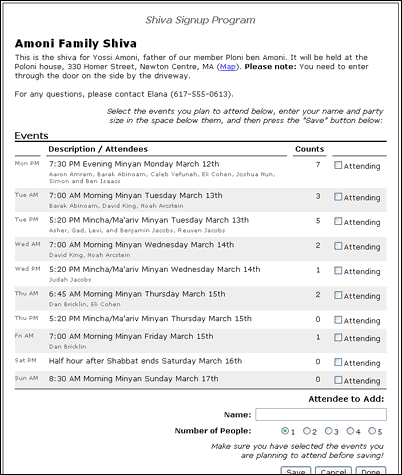danbricklin.com/log
|
||
|
|
Starting April 12, 2007
SocialCalc 1.1 released -- we now have a real Open Source project, Video of One Laptop Per Child keynote with demo, Podcasts from the OSS Summit, MTLC Open Source Summit, Podcast with Cringely and my first YouTube post, Thoughts about Admiral Mullen as the new Chairman of the Joint Chiefs of Staff, Issues with the Wikipedia "spreadsheet" page, Screencast of Buzzword Flash word processor, Podcasts with Virtual Ubiquity's Rick Treitman and Tabblo's Antonio Rodriguez, Happy birthday Dave and scripting.com, Podcast of David Weinberger at MTLC Social Media Cluster, Shiva signup program released
12Apr07-25Jun07
2007_04_12.htm
|
|
|
SocialCalc 1.1 released -- we now have a real Open Source project [link]
Socialtext has released SocialCalc 1.1. This is, as the version number implies, an upgrade from the wikiCalc 1.0 code. There are new features, bug fixes, a new source code organization, and new licenses.
You can find links to the source code and more at SocialCalc.org.
The new features include adding named range functionality and making colors easier to customize (starting with the "Socialtext color scheme"). Bug fixes include some with the COLS, INDEX, and ROWS functions, and some minor UI issues.
The source code has been reorganized into a directory tree that modularizes the main engine, the UI, and other files. It also relates to the licensing changes. The main spreadsheet engine (we'll call it "SocialCalc Engine"), which is in directories called "SocialCalc", consists of the Perl code that reads and writes data files, does the spreadsheet calculations and other operations, and renders the spreadsheet as HTML, and also consists of the Javascript code that enables basic editing. These "engine" components are separated from the rest of the product. That other part, which is called the "App", consists of the code for managing the files, the main application UI, the format-editing UI, file backup and other commands, etc.
The licensing changes are the most major change from wikiCalc. The wikiCalc code was released under the GPL 2.0 license. The SocialCalc code is being released in a different way to meet the needs of Socialtext, the company, and the developers they are targeting. Socialtext has been working on license wording for their main product, Socialtext Open. This is a complete enterprise-level content system consisting of wiki management, email integration, identity management integration, and more. Elements of the SocialCalc system, most notably SocialCalc Engine, are being integrated into that product.
The SocialCalc Engine code is being released under the Artistic License 2.0. This license, written by the Perl Foundation, is basically the same as the Artistic License used for years for Perl and was apparently just approved as "Open Source" by the OSI. (Perl also has the option of being used under the GPL.) I understand that this is a pretty liberal license which allows proprietary modifications but also allows code licensed under it to be included in projects licensed under GPL. This should hopefully help this spreadsheet engine code become part of a wide variety of projects and get a large number of developers contributing to its maintenance and advancement.
The "app" part of SocialCalc is first being released under the same license as Socialtext's (the company) most recent release of the Socialtext Open product. This is a license called the Socialtext Public License 2.0 (STPL 2.0), which is basically the Mozilla Public License 2.0 plus some additional requirements for attribution/promotion and a "network use" clause. This license has some issues and has not been accepted by OSI as Open Source at this point. Socialtext is working to improve the wording and is about to come out with a follow-on license any day now. The attribution/promotion clause of the STPL 2.0 allows the entities releasing the code to require display of attribution/promotional information subject to some restrictions. In the case of the SocialCalc app, we have chosen to make that requirement relatively minor (the actual requirement is a "fill in the blank" part of the license): The main user interface screen(s) must include a button labeled "Legal" that displays a copyright notice, a small logo image, a short phrase, and a URL. This display is not required if there is no UI and only applies to the SocialCalc app code, not the SocialCalc Engine code. This button requirement is similar to the way that the GPL suggests listing warranty and copyright information. It is similar to the "About box" in traditional GUI products, which frequently include a plethora of copyright and other notices. Unlike logo requirements on the main page itself, this "About box" requirement should work well in a wide variety of cases yet still make sure that it is clear where the code originated.
When Socialtext (the company) switches to a new license, the SocialCalc app code may be reissued under that new license. Socialtext Open (their enterprise-level wiki system) is much more extensive than the SocialCalc app and it may include more prominent attribution/promotion display requirements than was used for the SocialCalc app here. The exact requirements for each product will be determined by Socialtext when they release under the new license.
This is a real milestone. The code that started out as wikiCalc is in a real repository, the work is going on in public with a discussion group, and I'm now just one of many people working on this project. People are taking it in directions I didn't have the resources to do myself. Really cool.
Video of One Laptop Per Child keynote with demo [link]
At the Massachusetts Technology Leadership Council's Open Source Summit this week the keynote was a talk by One Laptop Per Child's Ivan Krstic and Eben Eliason. Ivan is OLPC's Chief Security Architect and Eben is a UI designer.
Ivan recently gave a talk at Google that focused on the security aspects of the software and other aspects of the project. Here the presentation (at least the second half of it) is much more about the software, including the UI, the software stack used, Open Source Software issues (he doesn't believe this project would have been possible without Open Source), and some live demos.
I think this is an extremely important project for many reasons. Unfortunately, much of what is so special is only obvious once you look at the details (which is why I did this video). This is not a "laptop" at all like a normal one you'd find in CompUSA. The hardware is quite different, the software is quite different, the goals are quite different. It is not a "toy" compared to a "real" PC. They are different beasts. This machine looks very real and very fertile for innovation. A "real" PC would not meet the needs of this project even if it cost only $50.
This meeting took place at Microsoft's offices in Waltham, Massachusetts. (The wifi there requires logging in each time you restart things, so there are some problems you'll see because of that, but it was something we ran into at that location before even with Windows machines.)
This is my first long-form video podcast. In the spirit of Massachusetts software, I published it on Brightcove. (I rendered it as a Flash 7 movie to maximize the number of players available, though that makes the video quality a little lower than, for example, Flash 8.)
You can view the OLPC keynote video by following this URL. It is about an hour and 10 minutes long.
Here are some other links you might find of interest:
Update: It's also available on Google Video at this URL.
Podcasts from the OSS Summit [link]
The Massachusetts Technology Leadership Council's Open Source Cluster's Summit took place this past Tuesday. I've finally finished processing the recordings of all the sessions and editing the video of the One Laptop Per Child keynote.
The audio recordings are broken up into 6 parts. Part 1 is the introduction by Bob Zurek with a welcome from Ted MacLean of Microsoft (which provided the facilities). Part 2 is a panel of lawyers (all of whom are participating in the GPLv3 drafting) talking about GPLv3 and what it tells us about the state of Open Source Software. Part 3 is a panel talking about Open Source Strategies, including Iona, RedHat, Novell, IBM, and Microsoft. There was a lot of discussion about the patent deal between Novell and Microsoft. Part 4 is a Lightning Round, with 6-minute presentations (mainly Powerpoint, not demos) about a series of Open Source or OSS-related products. Part 5 is the keynote about the One Laptop Per Child project. The last one is also available in video, and I'll write another blog post just on that.
To listen to these recordings go to Part 1, Part 2, Part 3, Part 4, and Part 5. These are on the Open Source Cluster's podcast RSS feed (with an HTML page available, too, listing all the previous recordings), not the normal podcast feed for this blog. Part 1 is about 10 minutes long, Part 2 about 40 minutes, Part 3 about 50 minutes, Part 4 an hour and a quarter, and Part 5 an hour and ten minutes.
Andy Updegrove live-blogged some of the meeting.
Here's a photo I took:
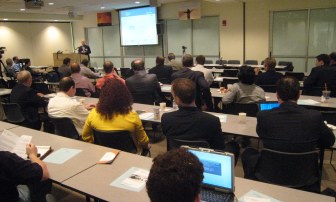 Getting all these sessions recorded was a real challenge for me. I had been at this facility recently and knew that the AV person was going to be out this morning. The setup there was tricky, with all sorts of buttons to push, lots of connectors behind panels, etc. It was unclear from my discussions with him before how I could do everything I needed for good sound, feeds into my recorders, etc. I did find out how to display video from a live camera so I could show the OLPC in operation (the VCR they have has an Aux input). I ended up bringing all the equipment myself: a wired mike at the lectern, a wireless mike for the panel and carrying around, a wireless lav for the last speaker and carrying around to audience members, a small PA system with speakers, three video cameras, a mixer, lots of wires and gaffer tape, and more. Whew! It is really tough to do some of the producing of an event, do the live sound, record it, and run three video cameras, all at once. But...because it would have cost a lot of money that nobody had pledged to the Council to do all this professionally, at least we got the podcasts and video. I hope you find them helpful. (I'll try to share what I've learned sometime here and on Podcorps.org.)
MTLC Open Source Summit [link]
Next Tuesday (June 16, 2007) the Massachusetts Technology Leadership Council's Open Source special interest group is hosting its second big "Open Source Summit". (The first one in 2005 was a big hit.) There are details about the meeting on the MTLC website. It is scheduled from 8am until noon and is open to both members and non-members. Surprising to some people, it will be held in a big room being provided by Microsoft at their facility in Waltham, Massachusetts.
The first discussion will be about the upcoming GPLv3, including presentations from members (all lawyers) of the GPLv3 Committees. There will then be a discussion of Open Source strategies from Iona, IBM, Novell, and RedHat. There will be a set of "lightning round" demonstrations of OSS and related projects. Finally, there will be a keynote by Ivan Krsti, Director of Security Architecture, One Laptop Per Child, where he will "...dive into the challenging engineering behind the OLPC software platform, covering everything from its unusual firmware to its new child-friendly GUI." He'll bring a unit to play with, I understand. Most presentations you see are about the project and hardware -- this one is more about the software.
I will try to record the meeting on audio, and hopefully videotape the keynote, but I can't promise anything (I'm also an MC of the meeting...). If you can attend, please do.
Podcast with Cringely and my first YouTube post [link]
Last Wednesday I received a call in the late afternoon from Robert Cringely. He was in town working on a new PBS special. He was wondering if I'd be available later that evening for an interview for the TV special. Luckily, I was. He showed up with a camera crew. They decided to use my "studio" in my office (where I recorded my software licensing training video). I videotaped some of their set up, and may show that when the show comes out (maybe in the spring of next year).
While we were waiting for the crew to set up (they used some of my lights and needed to add their own and set up the sound equipment, etc.) I asked Bob if I could record a podcast interview with him. He agreed. So, I interviewed him for the podcast, and he interviewed me for the TV program.
To listen to the interview with Bob, see "Robert Cringely of PBS" on my podcast page.
I videoed a few seconds of the interview (the part that starts about 4:45 into the 16+ minute podcast). I uploaded it to YouTube to share:
This is my first YouTube post for this blog. I hope it adds something.
Thoughts about Admiral Mullen as the new Chairman of the Joint Chiefs of Staff [link]
Yesterday I heard that it looks like there will be a new person, Admiral Michael Mullen, nominated as Chairman of the Joint Chiefs of Staff of the United States. As I wrote last March 7th, I attended a small conference where I got to spend time with Admiral Mullen and others from the Navy. I watched Admiral Mullen give an hour talk, answer questions, and spend free time with the rest of us trying to learn as much as he could. He was very open to discussion, listened carefully, clearly cared about people everywhere in the world, and was very personable. One of his deputies shared a panel titled "The Moral Consequences of the Networked Economy" with EFF's John Perry Barlow, Chunka Mui, and Diamond chairman Mel Bergstein. The discussions at the conference were off the record, so I won't say too much else in detail.
If you are interested in learning as much as you can about this change, which I think is important, you should read my post at the time, and listen to the podcast of the 20 minute interview I did with Vice Admiral John Morgan. Admiral Morgan is the Deputy Chief of Naval Operations and talked a lot about Admiral Mullen's initiatives.
Researching for this post, I found that Admiral Mullen himself started a personal, CNO Podcast last week (subscribe here). In his first podcast he even talks about possibly starting a blog if he can find the time. With this change to Chairman, I wonder if he'll be able to keep that up, but I hope that he does. It is very personal, and clearly is in the spirit of a "real" podcast -- he does not sound like someone reading a script. He uses an iPod himself (typically for listening to books) and understands this is a different, important media.
As a first reaction to hearing this news, here are some of my thoughts:
Admiral Mullen has a very long-term (5-25 year) view of things. This includes winning the hearts and minds of people around the world by doing good things, using our "soft power" for good in response to natural and other disasters, and cooperation, even with our enemies. It includes workforce issues such as having enough young people in the USA who want to be engineers.
His vision for the future talks about our response to the tsunami in Indonesia: "...dozens of ships and helicopters and thousands of sailors and Marines, all collected and connected for one purpose: to save lives, provide security, and restore a sense of hope. We literally built a city at sea for no other purpose than to serve the needs of other people. Aside from the lives we -- along with our international partners -- helped save, we started changing hearts and minds. We started showing them a side of American power that wasn't perceived as frightening, monolithic, or arrogant."
He advocates for the idea of the "1,000 Ship Navy" that is achieved not through building more ships but rather through cooperation with other governments and with commercial sea carriers, much in the spirit of Open Source Software development. Apparently, last summer he got President Bush to approve this plan for building a "community of trust" with other countries.
The Navy's main page about him starts with this quote: "Perhaps the most profound effect of today's challenges is the increased value of cooperation between friends, allies, coalition partners, and like-minded nations. Despite differences in the size or structure of our navies, cooperation today is more necessary than ever before. "
The Navy has a mindset that is probably different than the other armed forces. They are used to teamwork, but more autonomous in a distributed way. A ship captain has enormous freedom, going back to the days before radio. The Navy is used to dealing with continual, non-sovereign-state issues, such as weather at sea and pirates. They provide support for others, not just use of their own force directly. They are heavy users of Internet-related technology. These are issues that affect others and require cooperation among many, normally competitive, parties.
It will be interesting to see how this plays out.
Issues with the Wikipedia "spreadsheet" page [link]
There has been much written about the issue of people editing articles about themselves in Wikipedia. As I understand it, the practice is frowned upon for various reasons by many people. Ross Mayfield has written some on the subject. There's always the issue of bias on the part of the author (you) with regards to the subject (you).
I've run across a related issue -- writing about your work, which, of course, may affect your biography indirectly.
This is a real problem. Who knows more about something you worked on than you and others heavily involved in a field? On the other hand, there is a tendency to sometimes only know of your own work and miss its place among all the work of others before it and around the same time. For people trying to write the history, it is hard to find material to check out someone's claims.
In my consulting as an expert witness, I have found how hard it is to locate written material to document the state of various software back in the 1960's, 1970's, and even 1980's. Those products are no longer used and the manuals are not online. (For example, the VisiCalc reference card, listing all the commands, is only online because I went to the trouble of getting permission from the copyright holder -- IBM/Lotus -- and happened to have a 20 year old copy and wanted to put it on my web site. Most product developers don't have the old manuals from 20+ years ago, and don't have permission or good reason to post them.)
I write about this here instead of on Wikipedia because, as you will see, I have a clear potential for bias, even though I may have more knowledge of some of the subject than most of the people who will be writing the final article. I want to take advantage, as Dave Winer has pointed out, of using a blog to give my point of view and let Wikipedia use its process to give a, hopefully, "Wikipedia-style Neutral" point of view. I'll also put a mention of this blog post in the "Talk" page associated with the article.
Here is the specific case: The Wikipedia page on the word "spreadsheet" has, as I write this, what I feel are lots of problems. (Here is a link to the version as it looks as I write this.)
This is a tough area for anyone to write about because of the ambiguity of the term, the span of time it covers, and the lack of easily accessed written history.
First, let's look at the ambiguity of the term. There is the old concept of a spreadsheet as data presented in rows and columns, especially when there are columns of related numbers, such as in bookkeeping and other ledger sheets. The term has also come to be used for the general idea of rows and columns, such as in a view into records of a data base, or any columnar report. Dear to my heart, though, the term is used for that genre of computer programs that I call electronic spreadsheets that work and "feel" like VisiCalc, Lotus 1-2-3, Excel, etc.
Can the term "spreadsheet" be applied to any type of computer program whose output looks like a spreadsheet (i.e., data in columns and rows)? What is an "interactive spreadsheet"? Is it any program that produces rows and columns of data in an online (type a key and get a response) system? Is it only ones that use a video screen? Is it only ones that have a cursor that scrolls through columns and rows of independent cells? Would you be surprised if you sat down to use something that said it was a "spreadsheet" and its operation and capabilities were quite different from the VisiCalc/1-2-3/Excel style? These are tough questions but ones that need to be addressed to organize such an article.
One would hope that the article would include a complete history of the genre of programs that create and manipulate spreadsheets, limited to those which meet some useful criteria, with some reasonable discussion about the elements of taxonomy that each represent. For each general type of such program you would expect some discussion of the popular and influential products of that type as well as some others that had interesting attributes. (Here I mean influential in the evolution of the design of the products as well as influential in terms of product adoption. I mean "interesting" as in something to learn from or be amused by, such as alternatives tried or novel approaches.) The evolution of the most popular use (the time from VisiCalc to Excel) would be examined carefully. Also, maybe the "things like VisiCalc and Excel" should be in one page and "things that create tabular output" should be in another, with cross-references between them. The above article organization is not the case of the Wikipedia "spreadsheet" page (as I write this).
What I find very strange is that a very large portion of the article is taken up by a single product, the "ICI Works Records System". It takes up, as I write this, over a dozen paragraphs listing lots of features and innovations. Surprisingly, VisiCalc is given just two paragraphs, with no explanation of its features or differences from what came before -- just a little history about me coming up with the idea and then a list of machines it ran on (the entire TRS-80 family is missing, among others). Even more surprising is how few sentences are given to Lotus 1-2-3, probably the most important electronic spreadsheet program with regards to the history of acceptance of personal computers in business. Even Microsoft Excel is barely mentioned, even though its syntax is used for showing how spreadsheets "usually" do things.
The "Concepts" section breaks things down as some users may see them, but does not seem to convey the deep understanding one who actually implemented a modern (or old) spreadsheet would have. That is, to me it sounds as strange as it would if a non-programmer were explaining programming concepts. For example, one of the most important aspects of a spreadsheet, how it formats numbers (using the FORTRAN/COBOL meaning of format -- decimal places, treatment of sign, commas, etc.) is incorrectly put in the data type subsection and the less important typographic formatting such as bold is listed as format (which is not a distinguishing feature of spreadsheets over other products, and wasn't even present in the original VisiCalc or Lotus 1-2-3). Also troubling is that the concept categories include some listed as specific to a single recent product, something you would expect in an article about that specific product but not in the taxonomy of a decades-old field.
This is an inappropriate balance for an overview article in an encyclopedia, especially for one of the main applications of computers (at least it was for many important years).
The writing of the section on the "Works Records System" seems particularly inappropriate. It reads like an advertisement for the product that tries to give it, in hindsight, the role of using all sorts of ideas, implying that it was the first to use some of them. For example, it claims use of incremental compilation, an idea older than the product, but tries to tie it to the modern feature of just in time compilation. It does not explain the features of the product in sufficient detail to determine if the claims are true with regards to the product, nor its relevance to the topic. The product is described as using an IBM 3270 display terminal, but, in the article for the 3270, that same program is not described like a spreadsheet, but instead states that "...cells could be defined anywhere on the screen (not necessarily in rows or columns)." From my recollection of the products of those days, giving so much emphasis to this product, and ignoring so many others of the time and before, gives a false impression of its importance to computer history.
From what is written there, it seems that the product was in the genre of products that used separate formulas which were repeatedly evaluated to produce output, but not with a large grid of independent cells. That isn't, according to the "Concepts" section of the wiki page, what a "spreadsheet" is supposed to be like. There were lots of products in those days that used formulas to produce "spreadsheet" (row and columns of numbers) output. Bob Frankston was familiar with one of these he encountered in the 1960's when he worked on interactive timesharing systems. I mention some of these in my page about "Was VisiCalc the 'first' spreadsheet?" The "Works Records System" product, as described, does not sound like what we call a scrolling, WYSIWYG spreadsheet today, and it is not shown to have any direct influence on the current designs.
Why this product is given such prominence throughout the entire article is something I think should be questioned. It may be an interesting product on its own, but not to the spreadsheet overview discussion. There is a claim that the "Works Records System" was a "fully [sic] implementation" of a spreadsheet "as a commercial product" that "...pre-dated Bricklin's version..." Based upon what I can see on Wikipedia, that claim, to me, seems false. It was not a full implementation of what we would call a spreadsheet (nor probably even a subset implementation) and it was not a commercial product, and there is no indication that it was the first to use some of the techniques discussed.
What saddens me, as a supporter of the use of wikis in general and Wikipedia in particular, is how this discrepancy with what I would have expected came about with regards to the "Works Records System" product. There are no citations that you can check, no scans of manuals to read to examine the features, no links to material about it, and little discussion. On the Imperial Chemical Industries page, it is listed as an internal product used unmodified for years. There is just a single claimed screenshot that shows no UI (and, given the proportional font, does not look like it came from a 3270 in 1974 as it implies) and lots of unsupported text.
The text and image for this product, as far as I can tell by looking at the page's history, was mainly provided by one of the people described in the article as an author of the product. That sounds like a situation similar to a person editing their own biography. There appear (on Google) to be few or no other references to this product that I can find except those written by the same author, who has been writing about it in quite a few places on the web and on Wikipedia. This does not, as I understand it, meet Wikipedia's standards for verifiability and reliability.
Does Wikipedia think the "spreadsheet" page meets their standards? Apparently not. Some of the information I question is listed with "citation needed" notations. Wikipedia currently lists the page as B-Class, meaning "Considerable editing is still needed...a serious student or researcher trying to use the material would have trouble doing so, or would risk error in derivative work..." according to their assessment scale. The page is listed as one of only 36 that are "Top-importance Computer science articles" -- "Subject is a must-have for a good encyclopedia" --- so they seem to feel it is important for this to be done well.
So, why do I write all this? It would be nice if a more complete and balanced history of the genre of spreadsheets was written for this entry. Hopefully I can do my part by pointing this out here on my blog where I can have my personal point of view. Then, others who have actually lived through heavy use of the various products (and not just the single one they created or used) can add their expertise and improve the Wikipedia page. This describes many of my blog's readers. For products before VisiCalc, these people will probably be in their late 50's or older. For those products after VisiCalc, I would hope that some of these people would be the type who wrote those "Advanced Guides to..." for VisiCalc, Lotus 1-2-3, Quattro Pro, Excel, and others, and maybe even understood or built their internals. Then, hopefully, I won't be so embarrassed for Wikipedia.
What do I learn from this? One person with an agenda can make a big, inappropriate difference on Wikipedia in a seemingly important and widely understood topic that has little participation from those with deep knowledge of the topic. Though this person may be well meaning, it can completely skew the article for long periods of time and help create an alternative "reality" on the web and perhaps, as Wikipedia says, "risk error in derivative work." But, hopefully, we'll also learn that you can point these problems out through other means (like the blogosphere), and then things get put together by the community as they should have been, possibly even elevating the article to a higher plane than it started. Most highly public "errors" have long since been corrected. Stephen Colbert makes a few comments on his TV show about elephants or librarians and within minutes pages are attempted to be changed. I wonder how long it will take for this article to reach an "A" class on the assessment scale.
Don't email me to defend or deplore the Wikipedia process. I am not looking to discuss "fixes" to that process. That is not a topic on which I want to spend my time. I just want the article in an area important to me to be good, and I don't want (and I guess maybe shouldn't be) the one to actually do it.
This is not that I want more credit. I get enough credit. As I think I showed in my "Was VisiCalc the 'first' spreadsheet?" essay, VisiCalc clearly deserves the special place in history it gets. However, lots of other good work went on in the field and people who did innovative or influential work should have it given its appropriate place in history, too, so we can learn from the history. I just think that the history should be discussed knowledgeably and fairly, especially in Wikipedia. The current version of the "spreadsheet" page does not meet that test.
Screencast of Buzzword Flash word processor [link]
Yesterday, Virtual Ubiquity opened up a limited preview of their Flash/Flex word processor, Buzzword. They were kind enough to let me be one of the testers. (I've known Rick Treitman for many years and some of the developers have worked with me in the past.) I asked if I could do a screencast and post it and Rick said that I may.
I have only used the product for a little while, and don't know a lot of its ins and outs. I made this screencast so developers could get some idea of the level of craftsmanship and innovation that the Virtual Ubiquity people are getting using the tools that they use (using their skill and experience, of course). As we look at where applications are going in the next few years, this product is being pointed to as a great taste. See how they addressed an old metaphor, a word processor producing pages for possible print, and took advantage of Flash. This shows how Flash can have a role even with all the cool things people do with more "traditional" Ajax, especially with text.
To view the screencast (in Flash video, of course), go to the "Buzzword Demo" page.
Podcasts with Virtual Ubiquity's Rick Treitman and Tabblo's Antonio Rodriguez [link]
I attended a roundtable discussion about disruption hosted by Business 2.0 and others yesterday. They should be posting highlights sometime in the future (it was videotaped). I arrived a bit early and managed to record two podcasts. The first is with Rick Treitman, CEO of Virtual Ubiquity. They are developing a Flash/Flex-based word processor. I've seen it and it is quite cool. Rick talks about it and what they get out of Flash, how they almost named their company "Graybeards Software", and more. It runs a little over 9 minutes.
 Rick Treitman (with his gray beard)
The second podcast is a short one (just about 3 minutes) with Antonio Rodriguez, whose company Tabblo was recently acquired by Hewlett-Packard. He's had both a Web 1.0 company (Abuzz) and now a Web 2.0 company acquired. Tabblo is staying in the Boston area.
The recordings are "Rick Treitman of Virtual Ubiquity 2007-05-03" and "Antonio Rodriguez of Tabblo 2007-05-03" on my podcast page.
Technical info: Both of these were recorded with my Zoom H-4 using a Sennheiser MD46 microphone. The H-4's limiter was turned on. The one channel was turned into two by Audition and then the volume adjusted with the Gigavox Levelator.
Speaking of gray beards, here's a picture of Bob Frankston, Steve Wozniak, and me from a reception before Woz received the Boston Museum of Science's 2007 Walker Prize this past Monday (I'm on the board of overseers of the museum):
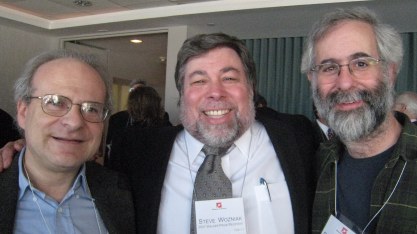 Bob Frankston, Steve Wozniak, Dan Bricklin
Happy birthday Dave and scripting.com [link]
Today is Dave Winer's 52nd birthday. Happy birthday Dave! Also, about a month ago, on April 1st, his blog scripting.com turned 10 years old. Happy belated birthday Scripting News! This combination, Dave and his sharing through his blog, have been quite important in getting the Internet to where it is today as a community communications medium. I'm one of many who would have started blogging and podcasting much later, or maybe never, if it weren't for Dave. His tools have also inspired me and others to develop ours. Thanks Dave, and I'm glad you're still here giving to the Internet and inspiring us to do the same. May you live to 120 (an old blessing)!
Here are some of the photos I've taken of Dave:
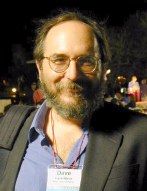   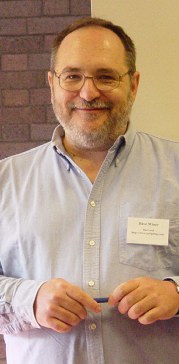 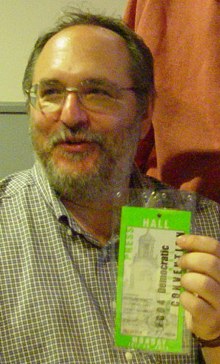 PC Forum 3/00, Harvard 2/03, Bloggercon I, Bloggercon II, before DNC Convention 7/04
Podcast of David Weinberger at MTLC Social Media Cluster [link]
David Weinberger gave a 30 minute talk to the Massachusetts Technology Leadership Council's Social Media Cluster this afternoon titled "Taking Back the Internet: How Social Media will Transform Media and Institutions". It was followed by an 80 minute discussion period that involved questions and comments from many of the 35 or so attendees and lots more from David. With David's permission, I recorded it as a podcast.
To listen to the recording, go to the "David Weinberger 2007-04-24" entry on my podcast page.
This was a chance to test out my new podcast recording equipment. The room was large, with people seated around tables and in rows behind them. David didn't use the room's sound system (and he paces a lot, anyway), and there were no mikes for the other attendees. Here are some pictures:
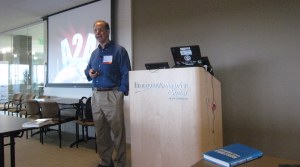 David Weinberger speaking
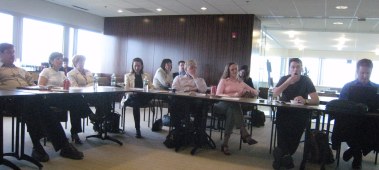 About a third of the room from early on, sitting at tables -- people continued to come in after this photo and sat behind these people
 My podcast recording equipment on the table near the front of the room near David
I think the recording came out pretty well given the variety of people speaking. For those of you who care about the details (and from the emails I get, I know some of you do) here's what I used, all carried in one shoulder bag and all battery powered: The recorder is a Zoom H4 flash memory audio recorder, recording an MP3 at 192Kbps. I checked the sound periodically on Sony MDR-7506 headphones. David wore a Sony UTX-B1 UHF transmitter which has an omni-directional mike clipped to his shirt. I connected a Sony URX-P1 UHF Tuner directly to the H4 for one channel of the input. (I have this pair from my video recording setup when I made my "Developer's Introduction to Copyright and Open Source" training tape.) I connected an Audio-Technica AT835B shotgun mike (with a Rode SM3 shockmount and Remote Audio REGRIP hand grip on a small Bogen mini-tripod) to the H4's other input channel with an XLR to XLR cable. During the first part, I left the shotgun on the tripod on the table pointed at David (though it wasn't needed because of the mike he was wearing), and then held the hand grip during the rest of the meeting to point the shotgun mike at whoever was speaking, be they close (e.g., me) or 10-30 feet away. David's mike also picked up some of the sound of the others speaking.
After I got home, I recorded a short introduction, brought the main recording and that intro into Adobe Audition, put the recordings together, and then mixed the two channels evenly. I then saved the result out as a WAV file and used, for the first time, Gigavox Media's The Levelator to automatically even up the audio levels so people in the back sounded as loud as David with a mike on his shirt. (Thank you Gigavox! The program did in 10 minutes what would have taken me hours by hand.) I brought the result of that back into Audition, added ID tags, and then saved the result as a 64Kbps MP3. I listen to some of it to check that it came out OK, and then uploaded the final file to the website. I used my ListGarden program to update my podcast feed. The whole process doesn't take much time (most of it is waiting for the conversions or file transfers, but I can do other things while that's happening) -- writing and posting this blog post takes me longer.
Shiva signup program released [link]
I've spent the last few months doing some expert witness work, some speaking (including at a conference on pen-centric computing at Brown University), some podcasting, and, of course, working on wikiCalc/SocialCalc. Socialtext employee Tony Bowden has been working pretty full-time, along with others, on integrating it into Socialtext's wiki system. It should be really cool when completed. I've been helping him with some prototyping and by adding some needed features to the code. When the first release of standalone SocialCalc comes out, it should be almost identical to wikiCalc 1.0 except for the colors used (blues instead of greens and browns) and the much-needed addition of named ranges.
Over the last several months, when I had a little time, I've also been working on a program that we needed for the religious community I belong to (the Newton Centre Minyan). The program has wide applicability beyond its initial use (which itself is wider than just our community), so I'm making it available as Open Source (GPL). This server-based program makes it easy to set up "sets of events" to which people can easily sign up using a browser. For example, you can use it to indicate which of 4 meetings you are planning to attend, which of several times would work for a meeting, which day you volunteer to provide food for a family in mourning, and more.
Here's the background: When a member of a Jewish family dies, the seven days after burial are a special time. Traditionally, during that period the mourners (close family members) stay at home and are visited by members of the community. This period is called "shiva" (pronounced "shih'-vah", not "sheev'-ah), which comes from the Hebrew word for seven. During that period the normal daily prayer services (as many as three a day) are held at their home (except on the Sabbath) during which the mourners recite the traditional "mourner's Kaddish" prayer. To do that, there must be a quorum (10 men or 10 adults above Bar-Mitzvah age depending upon the congregation) called a "minyan" (the service itself is often called a minyan, too, and so is a group that regularly prays together). It is often the responsibility of the congregation, not the mourners, to make sure that the minyan can take place.
With our volunteer-run group of about 160 families, ensuring there are enough people, organizing delivery of food, etc., falls to volunteers and has entailed lots of email and phone calling. (Ensuring attendance at a 6:45 am event on any random day on short notice, even during vacations, can be tough without some coordination.) Some members of our group started looking into online programs to facilitate all this. We didn't find anything we liked (would you like an ad-supported service that pops up ads for funeral things next to signup info read by family members?). Our community has members who have various needs during this period -- some "sit shiva" for some of the days in another city, some only want services on certain days, etc. I suggested that our needs could be served with a home-built system and that only a "small matter of programming" was needed to construct it and volunteered to build it myself. With the help of other members giving me feedback, testing demo versions, etc., I worked on the program in my spare time every once in a while.
At this point, we have been successfully using an early version of this program for a couple of months. Probably a hundred people have signed up for something at various points. Initially, only I could set up new sets of "events" (services in this case) to sign up for -- it was done with a simple text configuration file that was then uploaded by FTP. Recently, I've finally finished a version of the program that includes a complete browser-driven administration system that lets normal people (with the proper password) configure the program. At this point it's ready to release to the world (at least as a late beta version, though it may be the final version if it's not too buggy).
Unlike ListGarden and wikiCalc, this program is only available as a server-based program. It is a single file that, when installed and run on a server, does everything itself. No need for databases, etc. The idea was easy installation and maintenance so that an only slightly techie person can set it up and then others can take care of things themselves. Looking at the files it creates should make its operation very transparent.
Here is a sample screenshot of a signup page for a "set of events", in this case a fictitious set of services for the Ploni family:
Screenshot. Click on it to see an HTML version in your browser
I've also recorded a 10 minute screencast showing all the features (and to serve as training material).
To learn more about the program and find links for downloading, see the Shiva Signup Program Home Page.
As you'll see, the program is very much on the honor system. To make it easy to sign up, there is no login (except for administration). Everybody can see what everybody else has done. Anybody can sign up or edit as anybody else. This design has, so far, proven useful. For example, people without Internet access can call up others and have them add their name, etc. People have liked that they can see what others are doing and adjust their choices accordingly. This is all in the "wiki spirit" that has worked so far despite concern that it was too open. (It helps to keep the program at a URL only known to the group and not search engines.)
Working on this program has been a special joy. Not only was I doing something that I love, programming, but I was helping (and working with) a group I care a lot about in a way that makes use of my personal skills, I was helping in the fulfillment of an important good deed (a rough translation of "mitzvah" in this case), I was helping in the comfort of people I care about at a tough time, I was easing the burden on volunteers who have been helping us, and I was making a generally useful program. I hope this program indeed proves useful for others, both for scheduling comfort of mourners and for less emotional uses such as scheduling who brings the pretzels to a party.
|
||
|
© Copyright 1999-2018 by Daniel Bricklin
All Rights Reserved.
See disclaimer on home page.
|
||
